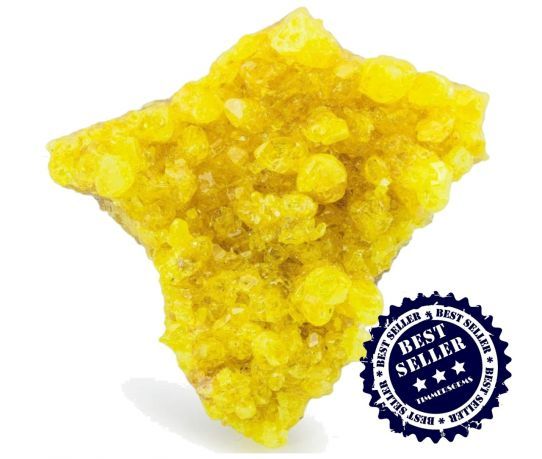We use cookies to make your experience better.
Sulfur group from Bolivia in beautiful dark clusters. Very popular with collectors of minerals.
Sulfur is a chemical element with symbol C and atomic number 16. It is a yellow non-metal. As early as the 9th century BC. it was known that a mixture of sulfur, coal tar, and is extremely flammable and, therefore, it has been regularly used in war operations. In the 12th century, was invented in China gunpowder that was a mixture of potassium nitrate, charcoal and sulfur. In mythology sulfur was often associated with hell. Former alchemists used for sulfur, a symbol consisting of a triangle with a cross thereon. By experiment, it was known that sulfur easily reacts with mercury. Around 1774 it was the scientist Antoine Lavoisier who discovered that sulfur is a chemical element and no connection. The sulfur name is supposedly derived from the Indo-European * suel- "swell", "cooking". Sulfur is a non-metal with a bright yellow color. As an independent element is odorless. In combustion emits a blue light, liberating the stabbing sulfur dioxide. In water, it is insoluble in carbon disulfide but it dissolves easily. The sulfur chemistry is an important branch of chemistry, mineralogy, environmental science and technology. The element itself forms a yellow crystalline solid with an orthorhombic crystal structure, which consists of a ring-shaped accumulation of S8 molecules. Powdered seems to be the fabric (except for the color) or on wheat flour (also known as flowers of sulfur). It is an insulator. At 112.8 ° C sulfur is going on in a monoclinic phase, which then melts at 119.0 ° C. The first liquid consists of S8 molecules and is then little syrupy. At higher temperatures, the viscosity increases enormously because ring opening and polymerization takes place. By quenching in cold water of the polymer melt is forming plastic sulfur, an amorphous form, however, gradually crystallizes. Sulfur boils at 444.674 ° C. On earth comes as sulfur compound in large quantities in minerals such as pyrite, galena, sphalerite, barite and gypsum. In volcanic areas, it is found in small quantities in its elemental form, often solfataren. On other planets with active volcanism, sulfur is frequently encountered. Jupiter's moon Io is a clear example. However, the main source of sulfur is the petrochemical industry where sulfur-containing components are removed from gas and oil in order to get a cleaner fuel. For example, hydrogen sulfide from gas is removed by means of amine gas treating and then, in the Claus process to be converted to elemental sulfur. In all living beings is because the sulfur amino acids methionine and cysteine sulfur compounds. That is to say that most of the proteins can not exist without sulfur. Since the petroleum originated from organisms is the occurrence of non elemental sulfur therein not strange.
| Dimensions | 20-40 mm |
|---|












